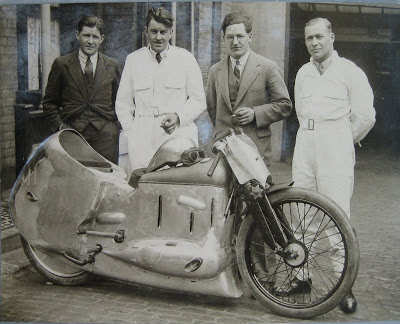
Alan Bruce was well-known in Speedway circles, having set the sidecar lap record at Wembley Stadium in 1931. Australians have a dirty affinity for three-wheeled cinder sliding, then as now, and one commonly sees Vincent-powered crabs even today kicking up dirt Down Under. Bruce got the notion of a sidecar Land Speed Record while watching Paul Anderson take a national record with his Indian outfit, down Sellicks Beach, South Australia, in 1925. It took another 6 years of toil to modify an S.S.100 Brough Superior for a total speed attempt; a supercharger was added to the engine bay, and Alan Bruce hand-pounded a shapely set of aluminum alloy bodywork… which as you can see from the photos addresses the issue of drag by streamlining the rear of the outfit (including the rider’s bum!). Which was the current thinking of the 1920s and early 30s, before extensive wind-tunnel testing of aircraft, cars, and lastly motorcycles, revealed that a very small frontal area was the real ticket for piercing the brick wall of wind which hits any vehicle at high speeds.
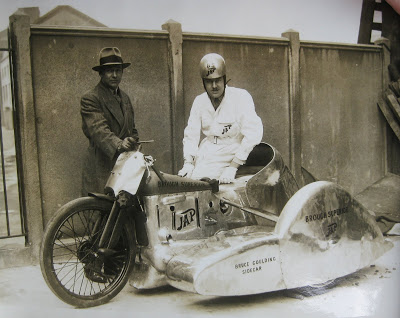
When finished, Bruce named his beast Leaping Lena, and sought a flat, straight road to set his record. In 1931, there were only a few suitable locations for a really fast run; Hungary (Gyon and Tat), Austria (Neukirchner), the U.S. (Daytona/Ormond beach), the U.K. (Pendine or Southport beaches), France (Arpajon), and Germany (Ingolstadt). As speeds increased for record attempts, beaches became increasingly undesirable due to Neptune’s fickle road-laying efforts, and attendant delays (read:money) for a perfect surface. As all but the beach venues were public roads, the political machinations (read:money) required to arrange a few days’ testing and eventual full speed runs could be daunting to a small and dedicated bunch of amateurs. And amateur is a fitting description for ALL speed-bitten enthusiasts, until National (Socialist) pride began investing in sporting contests, and little swastika roundels appeared on the tails of wingless two-wheeled aircraft. But I’m getting 5 years ahead of our story.
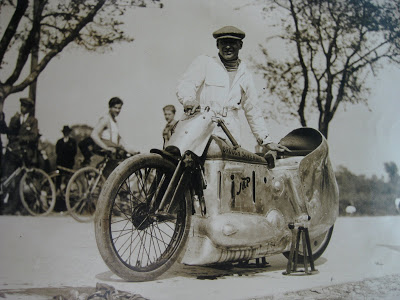
In 1931, Alan Bruce and Englishman Arthur Simcock took Leaping Lena to Tat in Hungary for a series of unsuccessful runs at the Motorcycle Land Speed Record, solo and sidecar. She can be seen at Simcock’s side in the top photo, sans third wheel, taken on site at Tat, where various mechanical issues beset them like gremlins, and the pair headed back to England for a winter’s work sorting out Issues like supercharged induction, etc. Note the copious oil leakage from the lower bodywork panels; one wonders if the lower ‘tub’ is in fact filled with oil! Late April 1932 saw our familiar pair of Bruce/Simcock joined by Phil Irving, who must have provided a measure of technical expertise to sort out the troublesome animal that was Lena. Chosen venue was Neukirchner, near Vienna, and local Brough Superior agents Eddy and Kent Meyer lent a hand in any way useful – Eddy being a real champion of the marque in Europe, having won over 80 ‘firsts’ in competitions with his Broughs. Arthur Simcock’s record run without sidecar ended abruptly when his goggles were blown off at speed, followed shortly by the supercharger safety valve blowing off. Local support for Lena ended there, as a local wag slipped a steel bolt into her induction tract and shortly ruined the supercharger, cutting their effort short while they frantically sought a new venue, and spares from England.
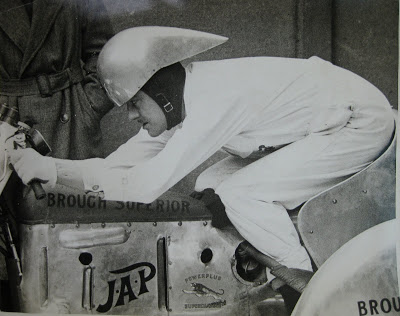
City officials of Tat were successfully cajoled (read:money) into allowing Lena’s run on short notice, and our crew high tailed it towards Hungary in their truck, which blew up and delayed their arrival. Meanwhile, Arthur Simcock trained back to England for blower parts, returning to find lousy weather (why April?), but it was decided that April 30th would be The Day, and it dawned with strong winds. Clearly, the slab-sided aluminum body of Leaping Lena wasn’t lethally beset by side wind handling anomalies, and a two-way average of 124mph was finally recorded, with a best one-way speed of 135mph… really going some for a rigid-frame bicycle on an iffy concrete surface. Bruce had the scare of his life while aviating the whole outfit at speed after hitting a bump with the chair wheel, the entire plot lurching nearly off the road. While distracted and momentarily shutting off, he didn’t realize he had passed the timing strips and carried on at full bore, only to hit a railroad crossing at 135mph! Man, motorcycle, and sidecar shot into the air, split the streamlining on impact, and nearly sheared off the carburettor, but the hard Aussie Bruce kept the animal between the hedges, and their day was done. As he said, “Yes, it felt fast all right!”

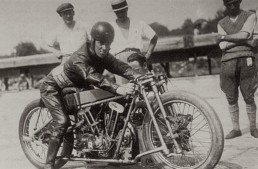
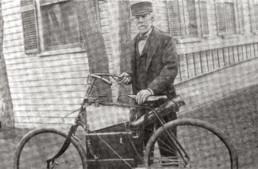
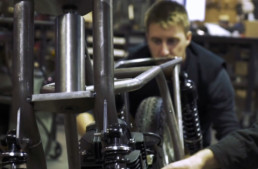
How many times have we heard pilots of fast machines coming off after a near disasters quote something similar
“yes is felt fast all right”
It sounds so much braver then making mention of having to find a restroom
I love the crazed suicidal expression on Bruce’s face in the photo below. So Glenn Curtiss would still be the fastest man on a motorcycle?
Great info Paul, as usual! Their streamlining efforts of the 1920s and 30s were actually an advancement on the minimized frontal area theory. Victor Page wrote about calculating frontal area of a bike/rider as early as 1914, it was pretty well understood then. But to minimize the Cd (coefficient of drag), they worked with their given frontal area and beat those aluminum panels into a shape that allowed good air flow off the backside of rider and bike.
I love that third photo. 😉
ciao
Pete
The more I follow your site and read stories such as this, the more I want them in a permanent form (ie. book) that I could use for those snowy day respites needed during our icey winters. Great writing, great site.
I do have 4 books full of my words: ‘Cafe Racers’ (MBI), ‘The Chopper: the Real Story’ (Gestalten), ‘The Ride’ (Gestalten), ‘The Ride: 2nd Gear’ (Gestalten)